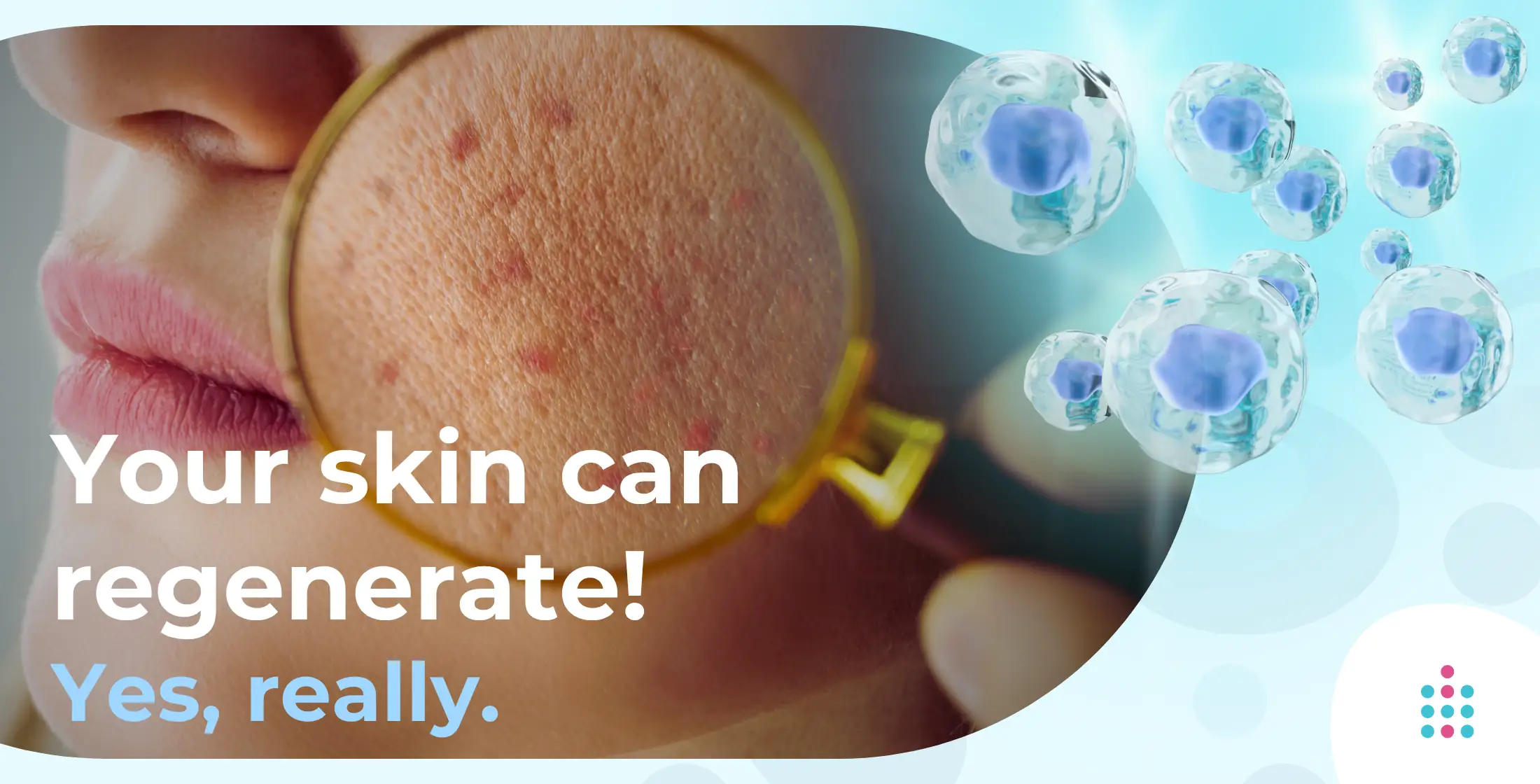At Stemwell – Regenerative Medicine, our mission is to merge innovation with evidence-based science to improve outcomes for patients. As we observe the European Day for Skin Cancer Prevention on June 13th, we take this opportunity to raise awareness about sun safety and explore ongoing scientific research in regenerative medicine related to skin health.

Genomic Insights in Skin Cancer
Skin cancer comprises several malignancies with diverse molecular profiles. In cutaneous melanoma, frequent mutations—such as BRAF V600E, NRAS, NF1, and KIT—activate major pathways like MAPK and PI3K/AKT, driving tumor development and guiding targeted therapy (Kim & Kim, 2024; Mirek et al., 2024; Yang et al., 2020). Additional alterations in genes including GNAQ, GNA11, PREX2, ERBB4, PPP6C, FBXW7, PIK3CA, and IDH1 further modulate disease behavior (Tímár & Ladányi, 2022). High tumor mutational burden (TMB), largely from UV-induced DNA damage, underpins melanoma’s immunogenicity and responsiveness to checkpoint inhibitors (Zob et al., 2022).
Basal cell carcinoma (BCC) and squamous cell carcinoma (SCC) exhibit distinct genomic signatures: BCC often features Hedgehog pathway mutations in PTCH1 and SMO, while SCC frequently involves TP53 and NOTCH1/2 mutations along with DNA repair gene dysfunction (Seviiri et al., 2022; Nikolouzakis et al., 2020). Genome-wide association studies have also identified susceptibility loci related to pigmentation, immunity, and genomic integrity (Zob et al., 2022; Varshney et al., 2024).
Molecular Testing and Risk Stratification
For melanoma, molecular diagnostics such as BRAF V600 mutation testing remain standard for guiding targeted therapy. Broader next-generation sequencing (NGS) panels are used to detect mutations in NRAS, NF1, KIT, and others, supporting therapeutic decisions and clinical trial eligibility (Kim & Kim, 2024; Yang et al., 2020). Gene expression profiling assays (e.g., DecisionDx), fluorescence in situ hybridization (FISH), and myPath are also utilized to aid in diagnosis and prognostication.
Although less established in BCC and SCC, molecular testing is emerging for complex cases, especially in advanced disease. Biomarkers such as telomere length, CpG island methylation, and microRNA profiles are under investigation for their diagnostic and prognostic value (Varshney et al., 2024; Nikolouzakis et al., 2020). Polygenic risk scores derived from GWAS are being developed to stratify high-risk populations, including immunocompromised individuals (Seviiri et al., 2022).

Advances in Regenerative Medicine: MSCs and Skin Health
Regenerative medicine continues advancing through studies on mesenchymal stem cells (MSCs), especially umbilical cord-derived MSCs (UC-MSCs). These cells have demonstrated immunomodulatory and regenerative effects in dermatological contexts, including skin rejuvenation, burn healing, and chronic inflammatory conditions like psoriasis and scleroderma (Fan et al., 2020; Sierra‑Sánchez et al., 2021). Furthermore, the secretome—conditioned medium released by UC-MSCs—maintains skin homeostasis by regulating apoptosis, barrier integrity, detoxification, and inflammatory responses in ex vivo human and 3D models (Wang et al., 2022).
Regarding oncology, several in vitro and animal studies suggest MSCs may influence melanoma dynamics. Sheep-derived UC-MSCs inhibited proliferation, migration, and angiogenesis in A375 melanoma cells and modulated key pathways including AKT/STAT3/mTOR (Wang et al., 2018). Similarly, secretome from human UC-MSCs reduced viability and migration of B16F10 melanoma cells while increasing cell adhesion—a complex response that merits further investigation (Fernandes et al., 2023).
UC-MSC supernatants have also shown photoprotective benefits in UVB-induced skin damage models (Cheng et al., 2024) and UC-MSC-derived extracellular vesicles modulate pigmentation and matrix synthesis without inhibiting melanoma proliferation (Kee et al., 2025). Additionally, studies on skin-derived MSC secretome confirm its angiogenic role in wound repair (Robert et al., 2018; Waloski, 2019). However, no clinical trials have explored UC-MSCs as a treatment for skin cancer in humans (Sierra‑Sánchez et al., 2021; Fan et al., 2020).
Complementary Therapies: What the Science Says
Hyperbaric oxygen therapy (HBOT), nutrigenomics, and other complementary therapies are also under scrutiny. While HBOT is well-established in wound healing and hypoxic conditions, there is no strong clinical evidence to support its use in skin cancer treatment. Some preclinical models suggest HBOT may enhance immunotherapy or chemoradiotherapy by modulating the tumor microenvironment, but these effects have not been validated in human trials (Wang et al., 2023; Seledtsov & von Delwig, 2022).
Similarly, no clinical trials have demonstrated benefits from nutrigenomic approaches in skin cancer care. The term “nutrigenomics” does not appear as a recognized therapeutic modality in skin oncology literature from 2020 to 2025. Complementary and alternative medicine (CAM), including phytochemicals and herbal compounds like curcumin, may show anticancer activity in vitro but lack validation through rigorous clinical trials in humans (Hidalgo et al., 2022). Caution is advised due to potential adverse effects and drug interactions.
Conclusion
As of 2025, genomics remains the most informative and rapidly advancing area in the study and management of skin cancer. The integration of personalized medicine—through molecular testing and risk profiling—is reshaping prevention and therapeutic strategies. While regenerative and complementary therapies such as MSCs, HBOT, and nutrigenomics show promise in related fields, they have not yet been clinically validated for treating skin cancer.
At Stemwell – Regenerative Medicine, we are committed to advancing science while delivering innovative, personalized treatments. By participating in global awareness initiatives such as the European Day for Skin Cancer Prevention, we reaffirm our dedication to promoting safe behaviors, supporting ongoing research, and translating emerging science into better outcomes for our patients.
References
Cheng, L., Liu, J., Wang, Q., Hu, H., & Zhou, L. (2024). The protective effect of a human umbilical cord mesenchymal stem cell supernatant on UVB-induced skin photodamage. Cells, 13(2), 156. https://doi.org/10.3390/cells13020156
Fan, D., Zeng, M., Xia, Q., et al. (2020). Efficacy and safety of umbilical cord mesenchymal stem cells in treatment of cesarean section skin scars: A randomized clinical trial. Stem Cell Research & Therapy, 11(1), 244. https://doi.org/10.1186/s13287-020-01695-7
Fernandes, P., Gomes, A., & Coelho, P. (2023). Secretome of Umbilical Cord Mesenchymal Stem Cells: Potential Effects on Melanoma. Stem Cells Translational Medicine, 12(S1), S29. https://doi.org/10.1093/stcltm/szad047
Hidalgo, L., Saldías-Fuentes, C., Carrasco, K., et al. (2022). Complementary and alternative therapies in skin cancer: A literature review of biologically active compounds. Dermatologic Therapy, 35(11), e15842. https://doi.org/10.1111/dth.15842
Kee, L. T., Foo, J. B., How, C. W., et al. (2025). Umbilical cord mesenchymal stromal cell-derived small extracellular vesicles modulate skin matrix synthesis and pigmentation. International Journal of Nanomedicine, 20, 1561–1578. https://doi.org/10.2147/IJN.S497940
Kim, H. J., & Kim, Y. H. (2024). Molecular frontiers in melanoma: Pathogenesis, diagnosis, and therapeutic advances. International Journal of Molecular Sciences, 25(5), 2984. https://doi.org/10.3390/ijms25052984
Mirek, J., Bal, W., & Olbryt, M. (2024). Melanoma genomics – Will we go beyond BRAF in clinics? Journal of Cancer Research and Clinical Oncology, 150(9), 433. https://doi.org/10.1007/s00432-024-05957-2
Nikolouzakis, T. K., Falzone, L., Lasithiotakis, K., et al. (2020). Current and future trends in molecular biomarkers for diagnostic, prognostic, and predictive purposes in non-melanoma skin cancer. Journal of Clinical Medicine, 9(9), 2868. https://doi.org/10.3390/jcm9092868
Robert, A. W., Azevedo Gomes, F., et al. (2019). The skin regeneration potential of a pro‑angiogenic secretome from human skin‑derived multipotent stromal cells. Journal of Tissue Engineering, 10, 2041731419833391.
Seledtsov, V. I., & von Delwig, A. A. (2022). Oxygen therapy in traditional and immunotherapeutic treatment protocols of cancer patients: Current reality and future prospects. Expert Review of Anticancer Therapy, 22(6), 575–581. https://doi.org/10.1080/14737140.2022.2070153
Seviiri, M., Law, M. H., Ong, J. S., et al. (2022). A multi-phenotype analysis reveals 19 susceptibility loci for basal cell carcinoma and 15 for squamous cell carcinoma. Nature Communications, 13, 7650. https://doi.org/10.1038/s41467-022-35345-8
Sierra-Sánchez, Á., Montero-Vílchez, T., Quiñones-Vico, M. I., Sanchez-Diaz, M., & Arias-Santiago, S. (2021). Current advanced therapies based on human mesenchymal stem cells for skin diseases. Frontiers in Cell and Developmental Biology, 9, 643125. https://doi.org/10.3389/fcell.2021.643125
Tímár, J., & Ladányi, A. (2022). Molecular pathology of skin melanoma: Epidemiology, differential diagnostics, prognosis and therapy prediction. International Journal of Molecular Sciences, 23(10), 5384. https://doi.org/10.3390/ijms23105384
Wang, X., Wang, Q., Yin, P., et al. (2022). Secretome of human umbilical cord mesenchymal stem cell maintains skin homeostasis by regulating multiple skin physiological function. Cell Tissue Research, 391(1), 111–125. https://doi.org/10.1007/s00441-022-03697-8
Wang, P., Wang, X. Y., Man, C. F., Gong, D. D., & Fan, Y. (2023). Advances in hyperbaric oxygen to promote immunotherapy through modulation of the tumor microenvironment. Frontiers in Oncology, 13, 1200619. https://doi.org/10.3389/fonc.2023.1200619
Wang, W., et al. (2018). Umbilical cord–derived mesenchymal stem cells inhibit biological functions of melanoma A375 cells. Oncology Reports, 40(1), 511–517. https://doi.org/10.3892/or.2018.6446
Yang, K., Oak, A. S. W., Slominski, R. M., Brożyna, A. A., & Slominski, A. T. (2020). Current molecular markers of melanoma and treatment targets. International Journal of Molecular Sciences, 21(10), 3535. https://doi.org/10.3390/ijms21103535
Yue, F., Zhao, Y., Lv, Y., et al. (2025). Anti-tumor effects of sheep umbilical cord mesenchymal stem cells on melanoma cells. International Journal of Molecular Sciences, 26(1), 426. https://doi.org/10.3390/ijms26010426
Zob, D. L., Augustin, I., Caba, L., et al. (2022). Genomics and epigenomics in the molecular biology of melanoma—A prerequisite for biomarkers studies. International Journal of Molecular Sciences, 24(1), 716. https://doi.org/10.3390/ijms24010716
Varshney, K., Mazumder, R., Rani, A., Mishra, R., & Khurana, N. (2024). Recent research trends against skin carcinoma – An overview. Current Pharmaceutical Design, 30(34), 2685–2700. https://doi.org/10.2174/0113816128307653240710044902
Ready to learn more about stem cell therapy?

At Stemwell, our team of doctors are highly skilled in successfully supporting thousands of people with a range of stem cell treatments. If you would like to learn more about stem cell therapy you can contact us with any questions, or apply today to check your eligibility.



